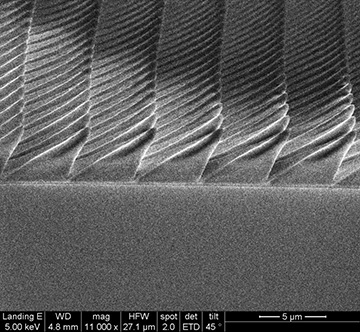
Sapphire sheet with asymmetrical micropyramids to produce more light in LEDs. [Image: Yin Lab / Penn State University]
Researchers from Penn State University, USA, have drawn inspiration from the glowing bellies of fireflies to design a more efficient light-emitting-diode (LED) bulb (Optik, doi: 10.1016/j.ijleo.2019.01.043). The design includes asymmetrical micropyramid structures, similar to those found on the surface of a firefly’s glowing abdomen, etched onto the outer surface of an LED.
The team says that quantitative simulations suggest that the uneven, obtuse slopes of its LED design can increase light-extraction efficiency up to 90 percent—an improvement on current commercial LED’s 50-percent extraction efficiency. Experimental results from the team’s proof-of-concept design verify higher light extraction with obtuse-angled asymmetric micropyramid arrays compared with symmetrical acute-angled arrays.
Brighter lights with lopsided pyramids
There are two ways of increasing light efficiency for LED bulbs: Maximizing quantum efficiency, the production of light, and maximizing light-extraction efficiency (LEE), the amount of light that actually leaves the bulb. The quantum efficiency of commercial LED bulbs has pretty much been optimized, leaving opportunities to improve LEE.
Current LED designs employ patterns of symmetrical microstructures etched into a sapphire substrate on the bulb’s surface to boost LEE. These microstructures function as gradient refractive-index layers that enhance LEE and randomize reflections and refractions of light off the structures and out of the bulb. While these orderly etched surfaces work well, they do not come close to reaching the theoretically achievable 85-percent LEE.
While searching for a solution to maximize LED LEE, Stuart (Shizhuo) Yin and his Penn State colleagues turned to fireflies. One way that fireflies maximize the light emitted by their lanterns is with an abdomen patterned with microscopic arrays of lopsided pyramids. The researchers wondered if covering an LED bulb with uneven micropyramids would increase light extraction by offering more surface area for the light to exit and by providing more chances for backward-reflected light to bounce off the side of a micropyramid and escape.
To test this asymmetrical patterning, the researchers conducted quantitative simulations of asymmetric and symmetric micropyramid-patterned sapphire substrates (PSSs) using the three-dimensional finite difference time-domain method. The simulations showed that for an asymmetric micropyramid array made from PSS, an obtuse angle of 138 degrees resulted in a 90-percent LEE. When they performed the same simulation for PSS arrays with symmetrically patterned and flat surfaces, they obtained LEEs of 75.1 percent and 20.4 percent, respectively.
![]()
Glowing firefly, Photinus pyralis. [Image: Terry Priest / Evansville, IN, USA; Creative Commons]
Demonstrating the new design
For proof-of-concept testing, the researchers used ultraviolet photolithography to create sapphire sheets covered in arrays of asymmetric obtuse-angled and symmetric acute-angled silica micropyramids 1.0 µm wide and 0.5 µm high. They coated the sheets with a fluorescent dye so they could quantify LEE by measuring the strength of the fluorescence signal when the sheets were illuminated with a 532-nm laser.
When they compared the fluorescence signal intensity coming from the asymmetric obtuse-angle micropyramid sheets to the sheets with symmetric acute-angle micropyramids, the researchers found that the obtuse angles produced a light signal that was 30-percent more intense than the acute angles, confirming that the obtuse-angled structures increase LEE.
The researchers have filed a patent application for their design and hope to initiate collaborations with manufacturers soon. With the solid-state lighting market projected to reach US$85 billion by 2024, Yin and his colleagues believe that their new design could help meet the growing commercial demand for efficient LED lighting.
